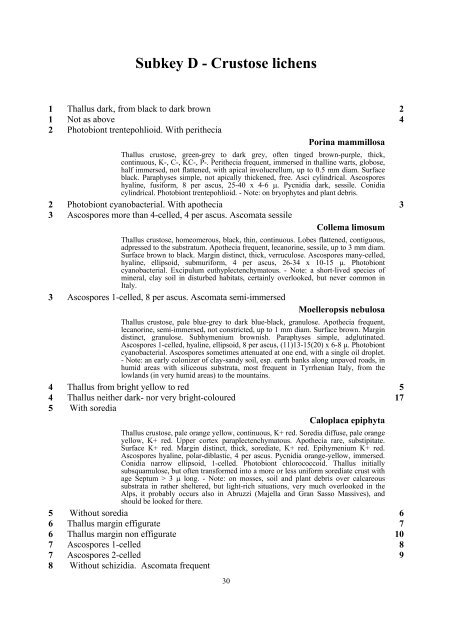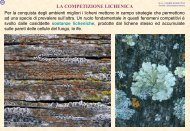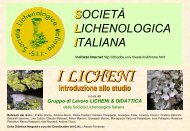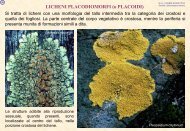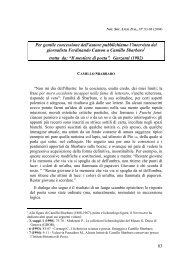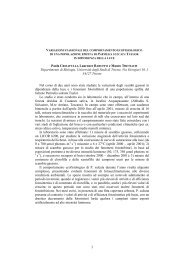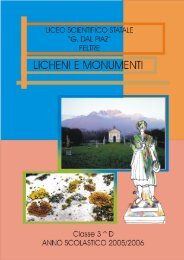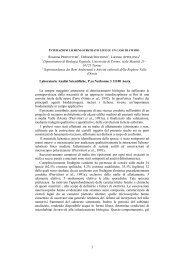KEY to terricolous lichens - italic
KEY to terricolous lichens - italic
KEY to terricolous lichens - italic
You also want an ePaper? Increase the reach of your titles
YUMPU automatically turns print PDFs into web optimized ePapers that Google loves.
Subkey D - Crus<strong>to</strong>se <strong>lichens</strong><br />
1 Thallus dark, from black <strong>to</strong> dark brown 2<br />
1 Not as above 4<br />
2 Pho<strong>to</strong>biont trentepohlioid. With perithecia<br />
2<br />
Porina mammillosa<br />
Thallus crus<strong>to</strong>se, green-grey <strong>to</strong> dark grey, often tinged brown-purple, thick,<br />
continuous, K-, C-, KC-, P-. Perithecia frequent, immersed in thalline warts, globose,<br />
half immersed, not flattened, with apical involucrellum, up <strong>to</strong> 0.5 mm diam. Surface<br />
black. Paraphyses simple, not apically thickened, free. Asci cylindrical. Ascospores<br />
hyaline, fusiform, 8 per ascus, 25-40 x 4-6 µ. Pycnidia dark, sessile. Conidia<br />
cylindrical. Pho<strong>to</strong>biont trentepohlioid. - Note: on bryophytes and plant debris.<br />
Pho<strong>to</strong>biont cyanobacterial. With apothecia 3<br />
3 Ascospores more than 4-celled, 4 per ascus. Ascomata sessile<br />
Collema limosum<br />
Thallus crus<strong>to</strong>se, homeomerous, black, thin, continuous. Lobes flattened, contiguous,<br />
adpressed <strong>to</strong> the substratum. Apothecia frequent, lecanorine, sessile, up <strong>to</strong> 3 mm diam.<br />
Surface brown <strong>to</strong> black. Margin distinct, thick, verruculose. Ascospores many-celled,<br />
hyaline, ellipsoid, submuriform, 4 per ascus, 26-34 x 10-15 µ. Pho<strong>to</strong>biont<br />
cyanobacterial. Excipulum euthyplectenchyma<strong>to</strong>us. - Note: a short-lived species of<br />
mineral, clay soil in disturbed habitats, certainly overlooked, but never common in<br />
Italy.<br />
3 Ascospores 1-celled, 8 per ascus. Ascomata semi-immersed<br />
Moelleropsis nebulosa<br />
Thallus crus<strong>to</strong>se, pale blue-grey <strong>to</strong> dark blue-black, granulose. Apothecia frequent,<br />
lecanorine, semi-immersed, not constricted, up <strong>to</strong> 1 mm diam. Surface brown. Margin<br />
distinct, granulose. Subhymenium brownish. Paraphyses simple, adglutinated.<br />
Ascospores 1-celled, hyaline, ellipsoid, 8 per ascus, (11)13-15(20) x 6-8 µ. Pho<strong>to</strong>biont<br />
cyanobacterial. Ascospores sometimes attenuated at one end, with a single oil droplet.<br />
- Note: an early colonizer of clay-sandy soil, esp. earth banks along unpaved roads, in<br />
humid areas with siliceous substrata, most frequent in Tyrrhenian Italy, from the<br />
lowlands (in very humid areas) <strong>to</strong> the mountains.<br />
4 Thallus from bright yellow <strong>to</strong> red 5<br />
4 Thallus neither dark- nor very bright-coloured 17<br />
5 With soredia<br />
Caloplaca epiphyta<br />
Thallus crus<strong>to</strong>se, pale orange yellow, continuous, K+ red. Soredia diffuse, pale orange<br />
yellow, K+ red. Upper cortex paraplectenchyma<strong>to</strong>us. Apothecia rare, substipitate.<br />
Surface K+ red. Margin distinct, thick, sorediate, K+ red. Epihymenium K+ red.<br />
Ascospores hyaline, polar-diblastic, 4 per ascus. Pycnidia orange-yellow, immersed.<br />
Conidia narrow ellipsoid, 1-celled. Pho<strong>to</strong>biont chlorococcoid. Thallus initially<br />
subsquamulose, but often transformed in<strong>to</strong> a more or less uniform sorediate crust with<br />
age Septum > 3 µ long. - Note: on mosses, soil and plant debris over calcareous<br />
substrata in rather sheltered, but light-rich situations, very much overlooked in the<br />
Alps, it probably occurs also in Abruzzi (Majella and Gran Sasso Massives), and<br />
should be looked for there.<br />
5 Without soredia 6<br />
6 Thallus margin effigurate 7<br />
6 Thallus margin non effigurate 10<br />
7 Ascospores 1-celled 8<br />
7 Ascospores 2-celled 9<br />
8 Without schizidia. Ascomata frequent<br />
30


